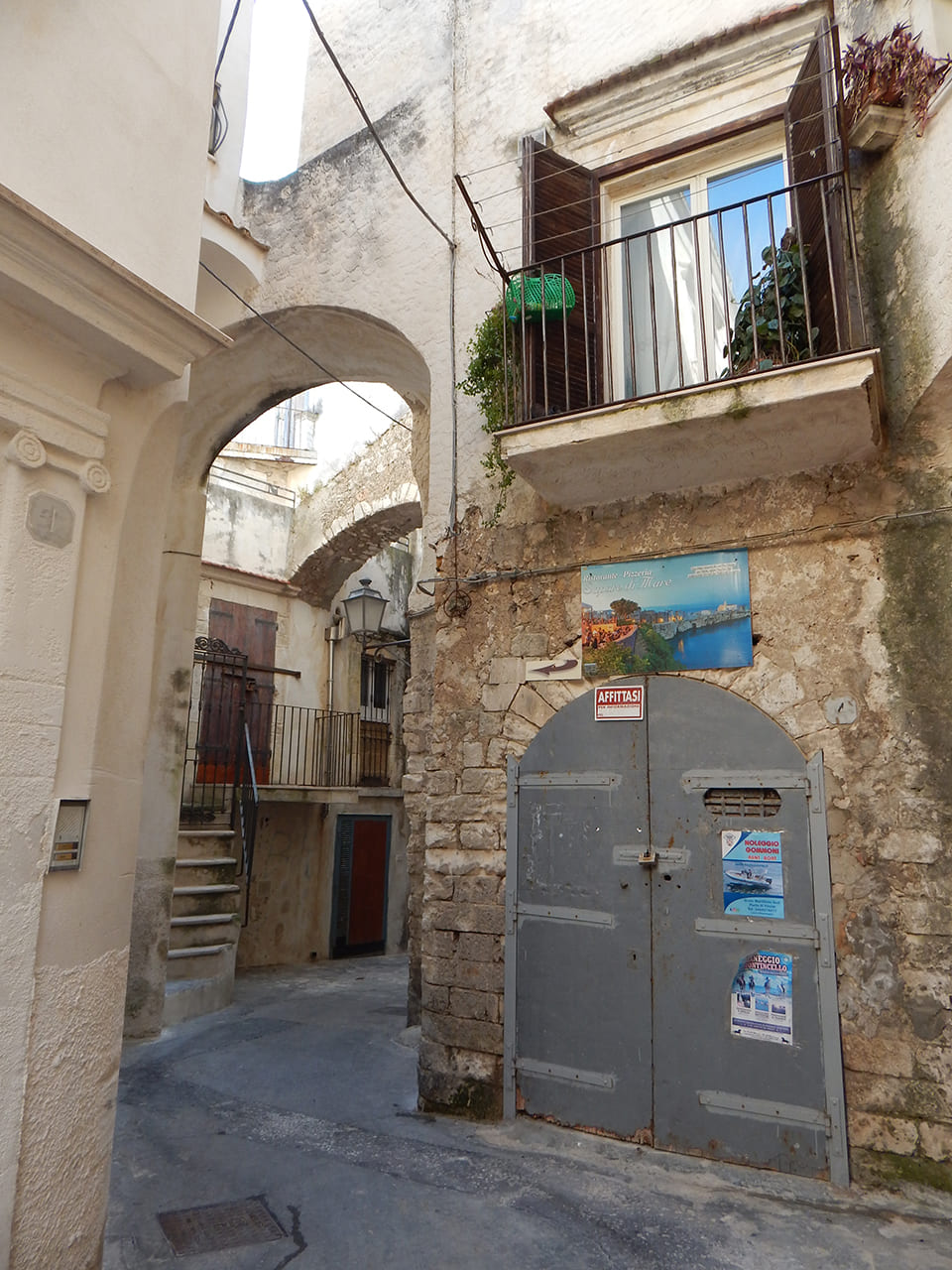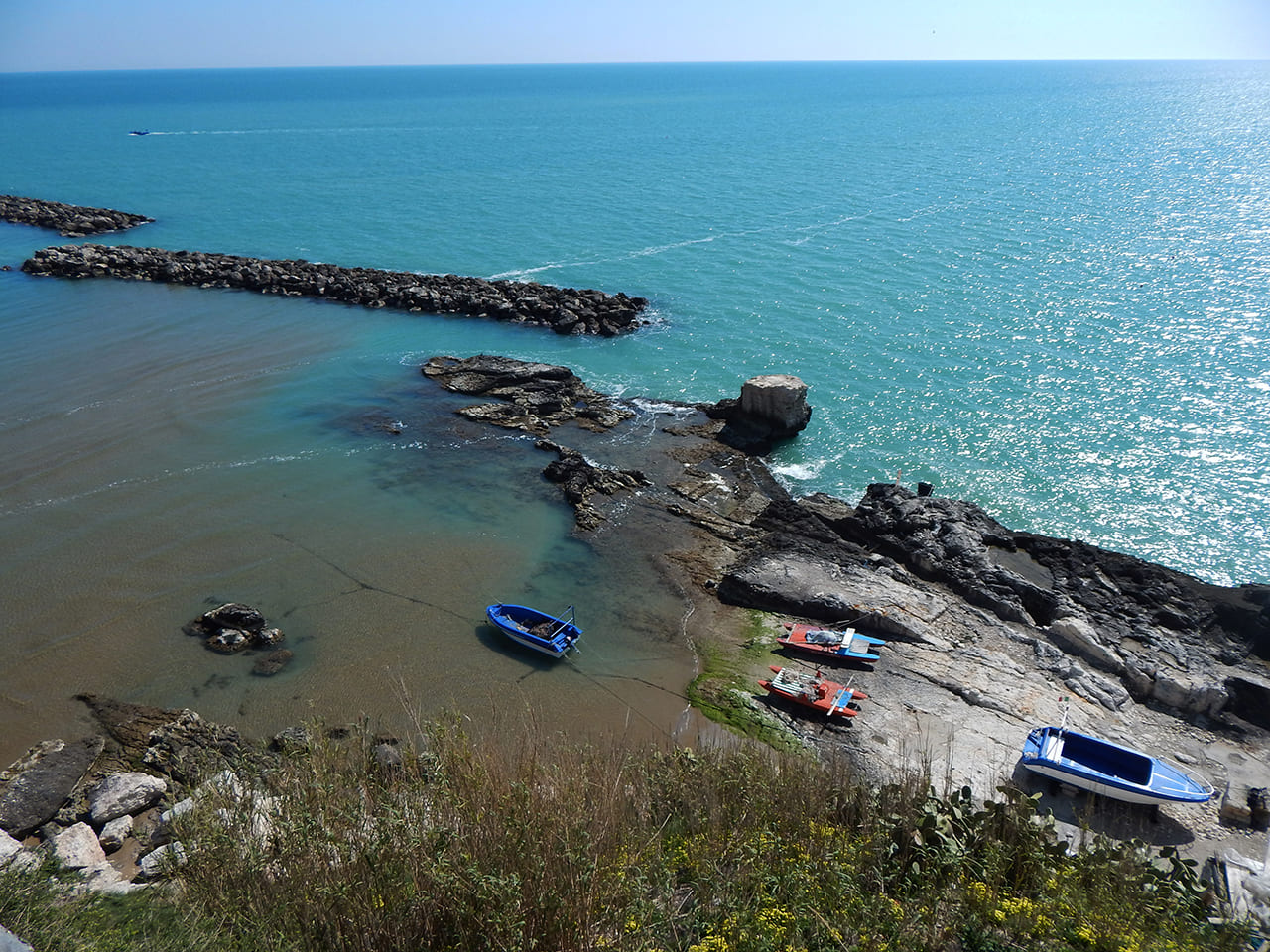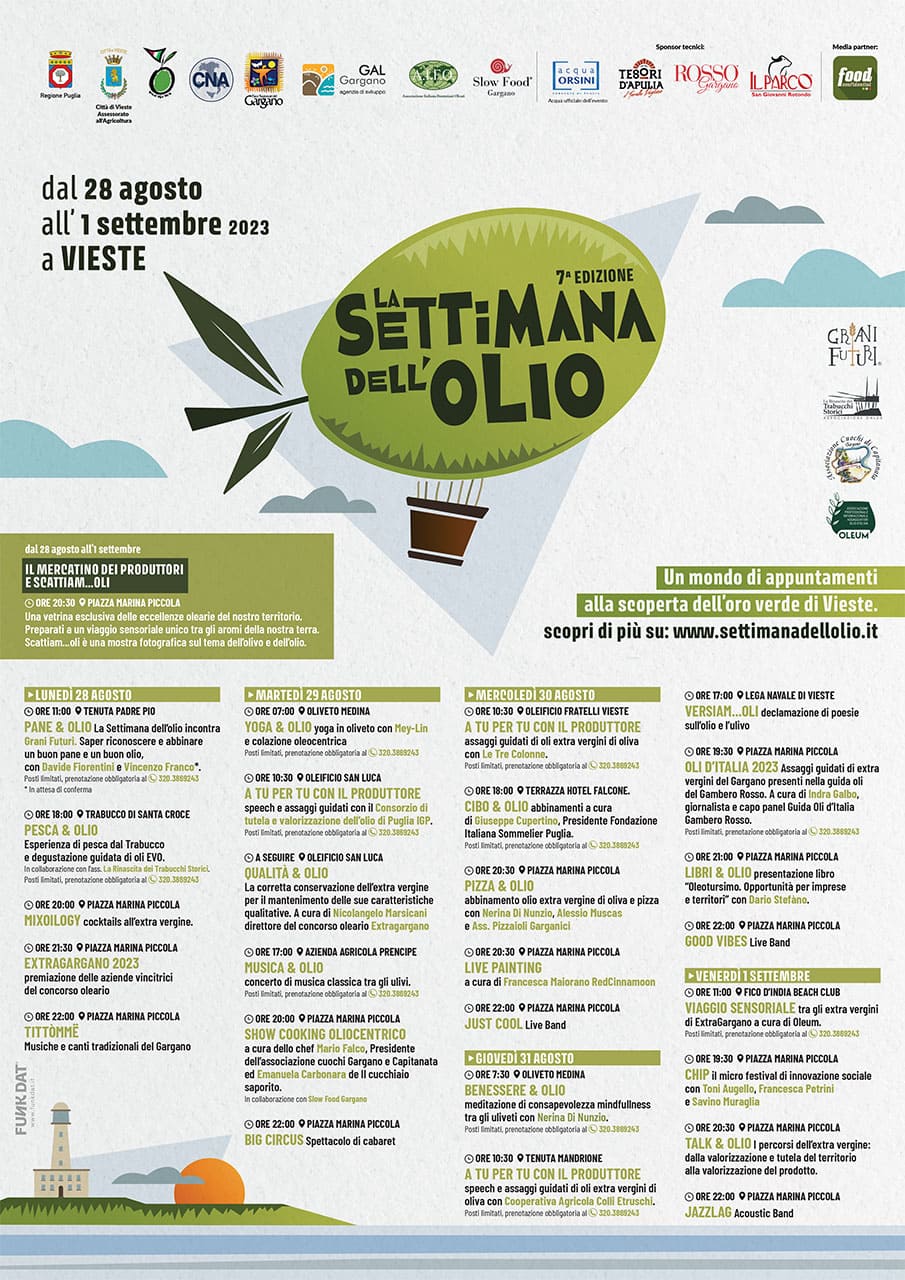La targa Via Judeca ricorda l’antico rione abitato dagli ebrei costituitasi a Vieste nel X secolo, formato da un piccolo numero di persone, crebbe dopo il terremoto del 1223 ospitando famiglie ebree salvate dal terribile maremoto che travolse la vicina Siponto. Il quartiere, molto più grande in origine, fu ridotto ad una semplice strada da diversi terremoti che fecero crollare la falesia della Ripa che la circonda. La formazione di questa piccola colonia fu favorita dalle attività commerciali che intraprendevano con altri paesi sfruttando la vocazione marinara di Vieste e i traffici marittimi delle navi di passaggio. A questa forma di economia si aggiunge quella agro-pastorale che faceva di queste famiglie degli produttori di formaggi e carni, di lana e di pelli di cui erano bravi conciatori. Il Professor Cesare Colafemmina, grande studioso delle comunità ebraiche, rivela che gli ebrei di Vieste praticavano, più per vocazione che per fine di lucro, la scienza medica. Nel 1456 un viaggiatore francese di origine provenzale, Ben Solomon Del Barri, approda a Vieste e qui ricopia le prime tre parti del trattato di medicina del Saliceto, prestato da un medico ebreo che abitava in questo rione. L’autore affascinato dalla bellezza del luogo scrive alla fine del suo manoscritto: “ho completato questo mio libro a Vieste, situata sul mare, 30 miglia in mezzo al mare nell’anno 5216: questo mare grande che è da ogni lato” Ben Salomon Del Barri era noto anche per le trascrizioni del “Libro dei Viaggi di Beniamino da Tudela”, del “Gioiello perfetto” di Abu1 Qasim e per le traduzioni dall’arabo dei trattati di medicina classica, ebraica e islamica. La comunità ebraica di Vieste si trasferì altrove dopo il terremoto del 1646 che distrusse l’intero quartiere. Successivamente colonizzata dagli abitanti del luogo, la Judeca di Vieste venne inglobata nel rione di San Giorgio. Lo slargo che affaccia alla fine della via è uno splendido affaccio sul mare infinito e tramite l’accesso di una scalinata si può raggiungere l’antico approdo sottostante. L’area rocciosa sottostante ancor oggi è usata dai pescatori locali e da bagnanti in estate, qui si può ammirare anche uno splendido scorcio di Punta San Francesco che è uno tra i luoghi più fotografati e famosi della Puglia. Sotto la Ripa, accanto alle barche dei pescatori si trova una piccola roccia a forma di cubo dove i giovani amano cimentarsi nei tuffi nelle assolate giornate estive, questa roccia è ricordata come la “Pietra dell’Innamorata” dove la triste Angelina, protagonista di una leggenda locale, scrutava il mare speranzosa del ritorno del suo amato sparito dopo una battaglia navale contro i Turchi al largo della costa.
The plaque “Via Judeca” recalls the ancient district inhabited by the Jews formed in Vieste in the 10th century and grew after the earthquake of 1223, housing Jewish families saved by the terrible tsunami that swept through nearby Siponto. The district, originally much larger, was reduced to a simple road by several earthquakes that caused the surrounding Ripa cliff to collapse. The formation of this small colony was developed by the trade made by the maritime traffic of passing ships. To this form of economy is added the development of the agro-pastoral economy which made these families excellent breeders and producers of cheese and meat, wool and leather of which they were good tanners. Cesare Colafemmina, a great scholar of the Jewish communities, reveals that the Jews of Vieste practiced medical science too. In 1456, a French traveller of Provençal origin, Ben Solomon Del Barri, arrived in Vieste and copied here the first three parts of the treatise on medicine of Saliceto, lent by a Jewish doctor who lived in this district. The author fascinated by beauty of the place writes at the end of his manuscript: “I completed this book of mine in Vieste, located on the sea, 30 miles in the middle of the sea in the year 5216: this great sea which is on every side” Ben Salomon Del Barri was also known for the transcriptions of the “Book of the Travels of Benjamin by Tudela”, the “Perfect Jewel” by Abu1 Qasim and for the translations from Arabic of treatises on classical, Jewish and Islamic medicine. The Jewish community of Vieste moved elsewhere after the earthquake of 1646 that destroyed the entire district. Later colonized by the local inhabitants, the Judeca of Vieste was incorporated into the district of San Giorgio. The widening at the end of the street is a splendid view of the infinite sea and through the access of a staircase you can reach the ancient landing place below. The rocky area below is still used by local fishermen and bathers in summer, here you can also admire a beautiful view on Punta San Francesco which is one of the most photographed and famous places in Puglia. Below the Ripa, next to the fishermen’s boats, there is a small cube-shaped rock where young people love to dive on sunny summer days. This rock is remembered as the “Stone of the Lover” where the sad Angelina, protagonist of a local legend, looked at the sea hoping for the return of her beloved vanished after a naval battle against the Turks off the coast.


MULTIMEDIALE
La Pietra dell’Innamorata è il luogo dove la protagonista di una triste leggenda andava a scrutare l’orizzonte del mare con la speranza di scorgere una nave con a bordo il suo Enrico. Questa leggenda pubblicata su Poliorama Pittoresco dove Antonio Fazzini, nipote del più famoso Lorenzo, la riporta sotto forma di racconto dal titolo “La Suicida del Gargano”. Si narra che la figlia del Capitano di Vieste, Angelina, era innamorata del valoroso Enrico, il comandante delle navi preposte alla difesa della città. Era un amore contrastato dal padre di lei che, seppur godeva di grande stima, non era dello stesso lignaggio della figlia. La mattina del 9 Maggio, giorno di S Maria, di un anno imprecisato dopo la distruzione della città da parte di Dragut, mentre il paese si preparava alla processione, apparve all’orizzonte dopo la Testa del Gargano, una nave saracena. Enrico con i suoi soldati si preparò a combattere per allontanare i pirati che tentavano di sbarcare a Vieste. La popolazione si riversò lungo il costone della città per assistere allo scontro quando all’improvviso apparvero altre navi nemiche. Iniziò una battaglia in cui sembrava che i soldati fossero vicini a soccombere quando il cielo si coprì di minacciose nuvole, di lampi e tuoni, cadde una incessante pioggia, si sollevò una fitta nebbia ed un violento uragano e le navi scomparvero alla vista dei cittadini. Le ore passarono, ma Enrico non rientrò in porto: della battaglia non si seppe più nulla. Angelina non si dette pace e quella notte non lasciò l’alta torre del castello scrutando l’orizzonte. Passarono i giorni e Angelina sola penava sperando sempre di rivedere ad un momento all’altro il rientro del suo Enrico. Un giorno un anziano pellegrino proveniente dalla Terra Santa divulga la notizia che il valoroso militare e i suoi compagni erano stati imprigionati dai Turchi e avevano rinnegato la loro fede sposandosi con delle donne arabe. Quando la notizia arrivò ad Angelina, tradita e delusa, cercò la morte e si buttò giù dalla rupe. Il giorno successivo, mentre i rintocchi funebri del campanile della Cattedrale annunciavano i funerali di Angelina, arrivarono a Vieste delle navi con Enrico e i suoi compagni. Appena sbarcato e riconosciuto da un marinaio che gli chiese: “Perchè siete venuto così tardi? Perchè avete rinnegato il nostro Dio? Perchè, crudele, avete tradito quella infelice?” Enrico allora capì e da quel giorno non apparve più in paese ma, nel buio della notte coperto da un mantello di pellegrino, era visto andare a sedersi sulla tomba dell’amata.
La Pietra dell’Innamorata (Lover’s Stone) is the place where the protagonist of a sad legend went to look at the horizon of the sea in the hope of catching a glimpse of a ship with Henry on board. This legend published in Poliorama Pittoresco where Antonio Fazzini, nephew of the most famous Lorenzo, reports it in the form of a short story entitled “La Suicida del Gargano” ( the Suicide of the Gargano). It is said that the daughter of the Captain of Vieste, Angelina, was in love with the brave Henry, the commander of the ships used to defend the city. It was a love opposed by her father who, although highly esteemed, Henry was not of the same lineage as her daughter. The morning of May 9, St. Mary’s Day, an undetermined year after the destruction of the city by Dragut, while the village was preparing for the procession, a turkish ship appeared on the horizon after the Head of Gargano. Henry and his soldiers prepared their ships and reached the pirates who tried to disembark at Vieste. The population over the cliffs of the town attended the battle when other enemy ships suddenly appeared. A battle began and the soldiers seemed to be on the verge of succumbing when the sky was covered with threatening clouds, lightning and thunder, a rain fell, a thick fog and a violent hurricane arose, and the ships disappeared from the sight of the citizens. The hours passed, but Henry did not return to port, of the battle no more was known. Angelina didn’t rest and that night she didn’t leave the high tower of the castle looking at the horizon. The days passed and Angelina alone was in pain hoping to see again at any moment the return of her lover. One day arrived in Vieste an old pilgrim from the Holy Land spreads the news that the brave soldier and his companions had been imprisoned by the Turks and then they had renounced their faith by marrying Arab women. When the news reached Angelina, betrayed and disappointed, she sought death and threw herself off the cliff. The next day, while the bells of the Cathedral announced Angelina’s funeral, various ships arrived in Vieste with Henry and his companions. He had just landed and recognized by a sailor who asked him: “Why did you come so late? Why have you denied our God? Why, cruel, have you betrayed that unhappy woman? “ Henry understood, and from that day on he did not appear in the village, but in the darkness of the night, covered with a pilgrim’s cloak, he was seen going to sit on his beloved’s tomb.
Auf dem Felsen der Geliebten schaute Angelina zum Horizont und wartete auf ihren geliebten Enrico. Die Tochter des Kapitäns von Vieste, Angelina, war in Enrico verliebt, den Kapitän der Verteidigungsschiffe der Stadt. Am 9. Mai, dem Fest von Santa Maria von Merino, erschien ein türkisches Schiff am Horizont. Also bereiteten sich Henry und seine Soldaten darauf vor, gegen die Piraten zu kämpfen. Alle Leute gingen zur Klippe der Stadt, um die Schlacht zu beobachten, aber andere feindliche Schiffe kamen an. Plötzlich gab es einen großen Sturm mit Blitz, Regen, Hurrikanen, und die Schiffe verschwanden ohne Neuigkeiten, und Enrico kam nicht zurück. Eines Tages erzählte ein älterer Pilger aus Jerusalem die Nachricht, dass Enrico und seine Soldaten von den Türken inhaftiert und arabische Frauen geheiratet hatten. Angelina war von den Nachrichten so am Boden zerstört, dass sie vom Felsen sprang und starb. Am nächsten Tag, als die Glocken Angelinas Beerdigung ankündigten, kehrte Enrico mit seiner Truppe zurück. Sobald er gelandet war, fragte ihn ein Seemann: “Warum so spät? Warum hast du unseren Gott abgelehnt? Warum warst du so grausam und hast sie betrogen?” Enrico verstand, was passiert war und tauchte nie wieder in der Stadt auf. Aber er war in dunklen Nächten gesehen worden, als er auf dem Grab seiner Geliebten saß. Diese Legende wurde in Antonio Fazzinis “Poliorama Pittoresco” mit dem Namen “La suicida del Gargano” (“Die Selbstmörder von Gargano”) veröffentlicht.















